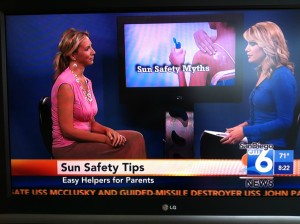Summer is here…and many well-meaning parents may actually be doing some more harm than good when it comes to sun safety.
While you never want to get burned – EVER – the sun is not the dangerous villain it is portrayed to be.
What I’m going to share here in no way means you should use reckless abandon and head outdoors the first day the sun is out when you are pasty white without protection. My goal is to educate you about other options for sun protection and to get parents to think twice about what products they use.
First off, sunshine is not the thing to be feared that it’s made out to be, however for many parents, it is automatic to lather up in sunscreen the moment there is any sun exposure.
In fact, safe sun exposure is healthy and critical for cancer prevention – but it is important to do it safely and understand a few things.
- Studies revealed that people who spend more time outdoors without getting sunburn actually decrease their risk of developing melanoma.
- Sunshine (UVB rays) help your skin produce a critically important hormone called Vitamin D.
- Natural Vitamin D3 (the kind your own body makes when exposed to UVB rays) is far superior to taking a vitamin D supplement – and there is no risk of Hypervitaminosis D, which can come from taking too much D in supplement form
- Body’s natural vitamin D3 is by far the best form available – supplements are not the solution – need to get levels tested.
- Skin cancer is caused by numerous other factors, sunburn being only one of those.
Why bathing in sunscreen every time you go outside may be more harmful than good
Our skin is like a sponge, and these chemicals in the personal care products we use, including sunscreen, are to varying degrees, absorbed into our bloodstream.
- Man-made chemicals in most commercial sunscreens are known to be toxic and even carcinogenic, some of these are known to become even more toxic when exposed to sunshine (a term called “phototoxicity)– absorbed into the bloodstream via the skin – For example, 90% of sunscreen brands contain octyl methoxycinnamate, which is proven extremely toxic when exposed to sunshine in particular, as is a known endocrine system disruptor especially with the thyroid.
- Not only are you preventing your body’s best cancer fighter, vitamin D, from being synthesized in your body, but you are also adding your body’s toxic load, which ultimately can lead to cancer
- The Environmental Working Group found that many higher SPF (SPF 30+) sunscreens do not provide additional protection, which leads to a false sense of security and increased risk of burning (which you don’t want)
- Cancer is not caused by burned skin alone – there are many other contributing factors, which are even more significant than sun exposure alone – in general, the more toxins we are exposed to, the more likely our chances of developing cancer
So because you never want to get burned, what is a parent to do if you are planning to go out in the sun?
Limit sun exposure until gradually building up
Start slowly, and build up a base tan that is one of your body’s natural defenses against burning. The time to get out of the sun is when your skin has turned an ever so slight shade of pink.
Wear protective clothing and hats
Whether it is a rash guard for swimming time, or just covering up exposed areas when outdoors, clothing and hats protect the skin on the body and face.
Diet
Diet can make a big difference in preventing sun damage and reducing cancer risk – (think internal sunscreen)
- Omega 3 EFAs – sources like fish oil and krill oil – 1-2 grams of EPA+DHA daily
- Eat raw vegetables and fruits – Antioxidants act similarly to an internal sunscreen and can prevent free radical damage caused by UVA rays. Best foods for sun protection include tomatoes, watermelon, broccoli sprouts and other cruciferous vegetables (broccoli, cauliflower), greens (kale, chard, collard greens)
- Astaxanthin is one of the best antioxidants and can help reduce burning, can be found in shellfish, salmon, red, yellow and orange colored fruits and vegetables (colored peppers)
- Reduce processed foods and eat organic foods as often as possible
- If it is not possible or practical to do the above, then use a SAFE sunscreen (thanks to Jimbo’s Naturally for their generous donation of products for the segment)
- EWG.org has these listed on their site – you can search over 1,800 products to see their toxicity ranking
- It is more expensive, but remember because you’ll be doing other things to protect your skin, you won’t be bathing in it every day so it will last a lot longer than a typical bottle
- Rather than being absorbed into the skin, it actually forms a physical barrier
My favorite brands:
Badger SPF 30 Sunscreen For Face & Body
Aubrey Organics SPF 30 w/Green Tea
Elemental Herbs Sunscreen Kids SPF20


My mother is a foreigner, and she did some things that we might consider “odd.” For example, during the summer we wore light, long sleeve shirts and huge hats. Just imagine the teasing from other kids… I never got sunburned until I was a rebellious teenager, laying out by the pool with my friends. My mother would just shake her head. When I read just now, “build up to it”… ah yes, that’s why I used to get sunburned. I guess mothers are always right. 😛